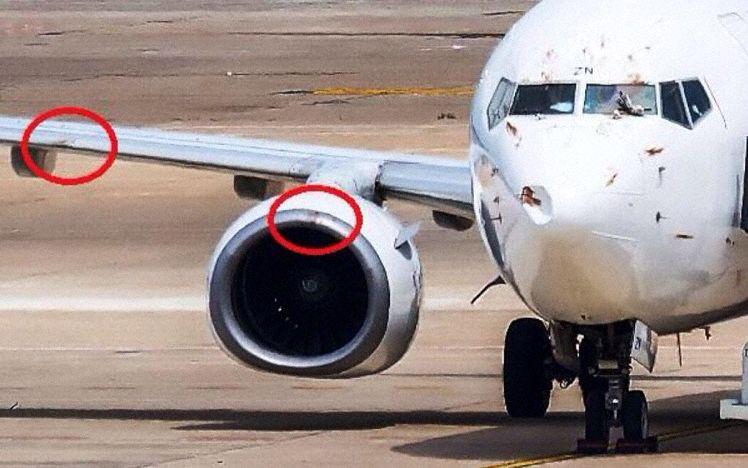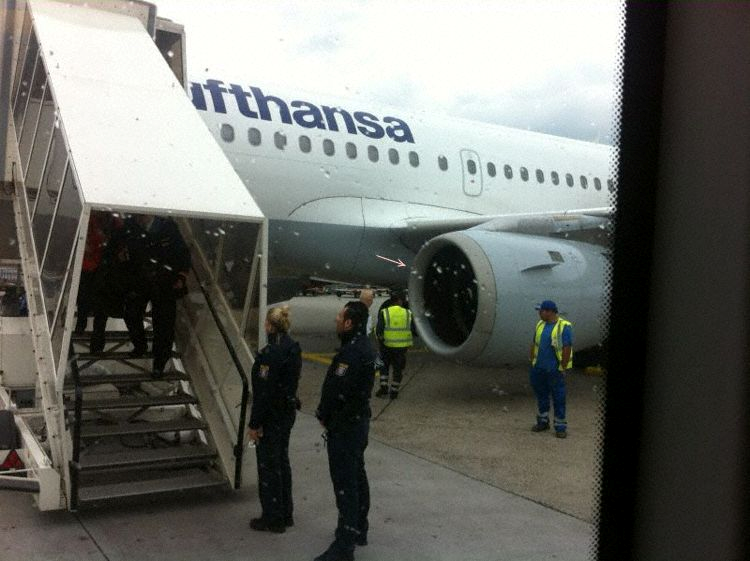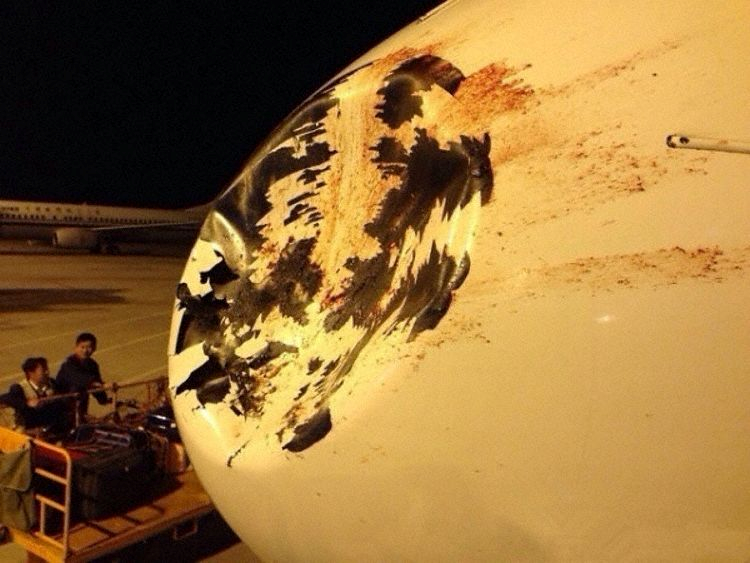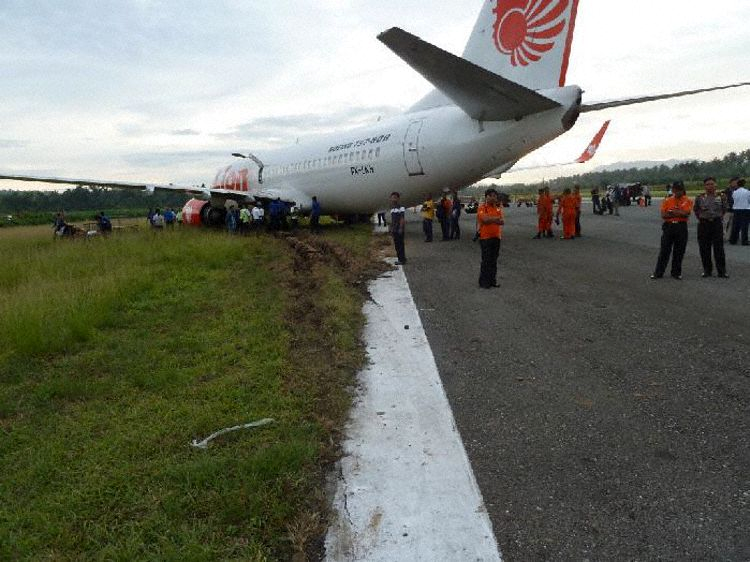 it
it  en
en
Archive 2014
The most relevant event of the month is definitely that occurred on the 30th at Lahore, when a Shaheen Air B737 veered right off the runway after landing. According to preliminary information the aircraft suffered a bird strike on the upper nose gear strut and received damage to the nose wheel steering control cable; however the runway excursion would have been caused by the collapse of the left main gear strut and therefore the relationship between these two events is still not clear. Actually the bird strike is supposed not to be the cause of the incident.
- 3 – Sacramento
Skywest CRJ200, bird strike on finale, minor damage; - 12 – Baltimore (MD)
Southwest B737, during the approach at about 4000 ft. flew through a large flock of birds; the crew initially reported damage to the flap leading edge and problem in their extension, then requested an emergency landing suspecting a bird ingestion into the right engine; - 14 – Yangoon
Air KBZ ATR72, at 3000 ft. during the initial climb struck a bird causing the left windshield to crack; immediate return; - 22 – Salt Lake City
Delta B737, bird strike on final with damage; - 24 – Orlando (FL)
Air Canada Rouge A319, rejected take off at about 100 kts. due to the ingestion of a Sandhill crane (Grus canadiensis pratensis) into the right engine with consequent loss of power; the fan blades received substantial damage; flight cancelled; the average weight of a Sandhill crane is 4 kilos; - 27 – Abuja
Arik Air B737, during the initial climb struck a bird that caused damage to the windshield; immediate return; - 28 – West Palm Beach (FL)
Bahamasair Dash 8, during the approach at about 6 NM from the runway flew through a flock of birds, at least one impacting the aircraft; minor damage; - 29 – Kathmandu
- Jet Airways B737, on final at 500 ft, the left engine ingested a bird causing the engine to surge and emitting streaks of flames; return flight cancelled;
- 30 – Lahore
Shaheen Air B737, on final approach at 100 ft. suffered a bird strike to the nose wheel steering control cable; after landing it veered right off the runway and came to a stop on soft ground with the left hand main gear strut collapsed; no injuries;
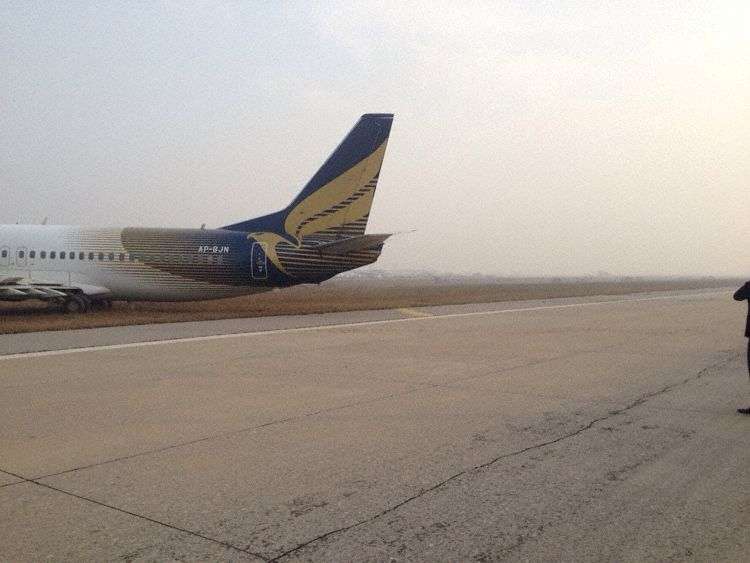
(Photo taken from avherald.com) - 31 – Cairns
Tigerair Australia A320, during the initial climb struck a bird; the crew decided to divert to another airport where they landed two hours later;
With the review of the relevant occurrences of December, which will be released in early January 2015, the monthly diffusion of the wildlife strike data will come to an end.
This website works in the field of prevention since 2007 and in these past seven years has tried to provide not only the news collected from the specialist press on the various events, but also comments, observations, articles, in other words everything that may help in raising the safety culture in this particular area.
In particular we believe we played an useful role in the legal field, publishing all the known Court sentences regarding wildlife strikes, as well as presenting the investigation reports issued by the various authorities worldwide.
From now on, the reports will be released at a quarterly rate; we come to this back step especially in order to contain the costs of maintaining and updating the website, which contains no advertising and does not receive subsidies of any kind. Certainly the feeling of common indifference and the ill-concealed condescending air that we perceive in the aviation world on these issues do not help; actually, to put it mildly, the phenomenon of wildlife strike does not seem to garner the attention it deserves. It appears as if the matter was confined in the precinct of the unavoidable events, so at the end of the day it would result more convenient strengthening the insurance coverage rather than increasing security measures.
A back step does not mean an abandonment of the field however ; we are and will remain attentive to what happens in Italy and all over the world and ready either to inform or to intervene, should anybody ask for our advice.
We take the opportunity to wish our readers a Merry Christmas and a safe and prosperous New Year .
Valter Battistoni
(Website owner and manager)
The event occurred on the 6th reminds us one of the basics of prevention against wildlife strikes: to have a solid and efficient fence. The airport of Surat (Indian town with more than four million inhabitants) became operational again for commercial flights in the year 2007, so it would seem difficult to think of a FENCE degradation due to the action of time and weather. This accident could have had much more serious consequences. The Indian authorities immediately ordered a series of investigations about all the country airports and Spicejet suspended its flights to Surat with immediate effect.
Few weeks later (30) another mammal, fortunately smaller, was struck on a runway, this time in Dayton, USA.
The event of the 8th raises concern because it is not clear when the engine has been shut down; in other words, if the impact with the buzzard surely happened on takeoff, we don’t know if the engine continued to run normally at least until the final approach, when it was definitely off, or if it was shut down immediately and the crew continued the flight to destination with a single engine: they are two very different situations.
But the most important event was undoubtedly that of the 12th in Aalborg, where the sixth dual ingestion (in a twin-engine) of the year occurred. Nobody should now speak of rare and statistically insignificant events.
- 1 – Orlando (FL)
Delta Airlines B757, rejected take off after a bird ingestion in the left engine; - 2 – New York (La Guardia)
on approach a bird impacted the radome causing minor damage; - 2 – Brno
Ryanair B737, airport sources report a bird strike on landing; return flight operated by a replacement aircraft; - 5 – Saarbruecken
Air Berlin A319, on approach an engine ingested a bird; other arriving aircraft were instructed to go around due to the presence of considerable bird debris on the runway, which was closed for about 25 minutes; minor damage to the engine; - 6 – Surat Gujarat
Spicejet B737, rejects take off due to the impact with a buffalo on the runway; three buffalos entered the airport through a hole in the fence; substantial damage; the Indian Airport Authority of India have received order to dispatch review teams to all airports within a month to check the safety of aerodromes;
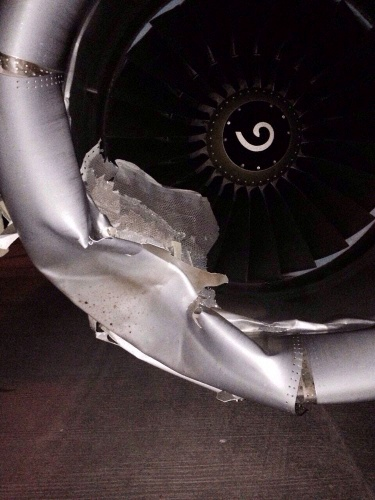
http://blogs.wsj.com/indiarealtime/2014/11/07/spice-jet-buffalo-hit-raises-security-questions-at-surat-airport
The damage to the left engine (photo taken from avherald.com) - 6 – Salt Lake City (UT)
Fedex MD11, during the approach two geese impacted the aircraft; damage to the radome and the captain’s high window; - 8 – Guernsey
Flybe Dash 8, shortly after departure a Common Buzzard (Buteo buteo) impacted the left hand propeller; the aircraft continued to destination where landed with the left hand engine shut down; it is not clear when the engine was shut down;
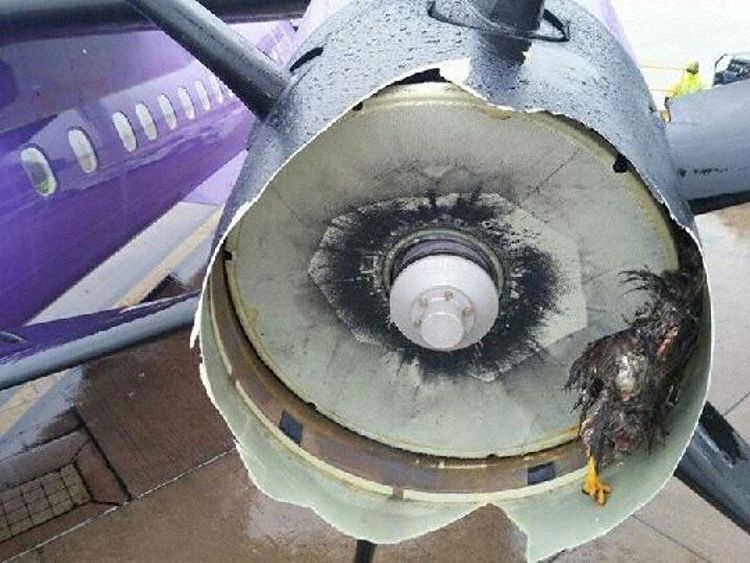
(The propeller cone seen after landing; photo by Douglas A. Shea taken from Avherald.com) - 10 – Zhuhai
China Southern A330, after a take off without apparent problem at 37.000 ft. the left hand engine emitted a loud bang and streaks of flames followed by a burning smell developing in the cabin; immediate diversion; the airline reported the engine surge was the result of a bird strike on departure; - 12 – El Salvador
Avianca ATR72 after take off the right hand engine was hit by a bird prompting the crew to return to land immediately; - 12 – Aracaju
TAM A320 during the approach a bird was ingested into an engine; return flight cancelled; - 12 – Aalborg
NorwegianAir Shuttle B737, during the approach flew through a flock of birds ingesting a number of them into both engines that continued to deliver normal thrust; return flight cancelled; it’s the sixth case of dual ingestion in 2014; - 13 – Baltimora (MD)
Southwest B737, on approach at 2500 ft. the aircraft flew through a flock of medium size birds; minor damage; - 14 – Oakland (CA)
Alaska Airlines B737, after take off the crew reported they had been hit by a large bird and lost some instruments; immediate return in emergency; - 16 – Raleigh/Durham (NC)
Delta MD88, during the initial climb the aircraft flew through a flock of geese and ingested a number of birds into an engine that was shut down; immediate return about 9’ later; - 18 – Goa
Air India A321, rejected take off due to a bird strike; one blown tyre; flight postponed to the next day; - 20 – Istanbul
THY A321, the initial climb the aircraft flew through a flock of gulls that caused multiple impacts; a fan blade of the left engine was damaged, sign of ingestion, as well as the flaps of the left wing; - 22 – Sacramento (CA)
Southwest B737, on final approach a bird impacted the aircraft that received damage to its nose cone; - 22 – Sacramento (CA)
Volaris A320, on final approach the aircraft ingested a bird into the left hand engine; which received "unknown damage"; - 24 – San Jose
TACA A319, during the initial climbing the left hand engine ingested a bird prompting the crew to shut the engine down and return about 15 minutes later; - 30 – Dayton (OH)
Expressjet E145, at the touch down struck a coyote on the runway receiving damage to the nose gear; the airport has a traffic of 2,5 million passenger/year and three runways;
As usual we present an article (in Italian) with comments to the annual report of the Bird Strike Committee Italy. For English speaking people a short summary is available here.
The 2013 BSCI annual report is now available (in Italian) in the ENAC official website:
Our observations and comments will follow soon, as usual, on this website.
The event of Oct. 2 in China let us understand that in some airport in the world a reliable bird control service is not yet available. Similarly it reminds us about the need for clear instructions to the crew by the airlines, and probably specific training, about the proper behavior in the event of flying through a flocks of birds and in the following phases.
- 2 – Tyumen
Yamal B737, during the initial climb flew through a flock of birds; in the absence of abnormal indications the crew continued the flight to destination; a post flight inspection revealed damage to the right hand engine; the airline complained that lack of bird control at the airport put their aircraft, crew and passengers at risk; - 4 – New York (JFK)
Jetblue A320, just after becoming airborne the crew reported a bird strike into the left hand engine; immediate return; - 5 – Ft. Lauderdale (FL)
Delta MD88, during the approach the crew reported they took a bunch of mallards causing damage to the radome that needed to be replaced; - 8 – Wuhan
Xiamen B737, during the approach flew through a flock of birds receiving multiple impacts; next flight delayed;
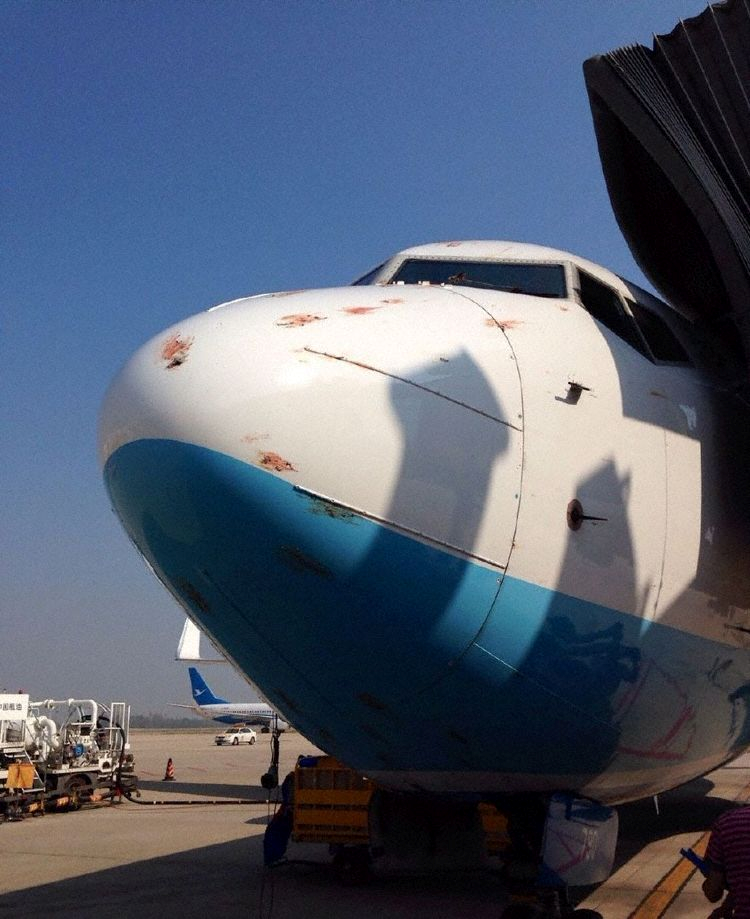
(Photo taken from avherald.com) - 11 – Istanbul
THY A320, during the initial climb an engine ingested a bird prompting the crew to return to landing; the aircraft landed about one hour after departure; - 24 – Arcata (CA)
Skywest Airlines EMB120, during the climb one or more birds imparte the windscreen causing damage to it; immediate return and flight cancelled; - 29 – Almaty
Lufthansa MD11, during the approach suffered a bird ingestion into the right engine; next leg cancelled;
The two events of the 9th at Zurich and Cluj seem they were made for emphasizing the differences in the pilot behaviors facing a bird strike on takeoff; in the first case, given the carcass found on the runway, doubts could arise regarding a possible ingestion. In our opinion that’s a praiseworthy decision.
Four events in few days at Amsterdam, that follow other three in August: we don’t know anything about the species involved but everything suggests, given the current season, they are cases linked to bird migration.
- 2 – Rio del Janeiro (S.Dumont)
GOL B737, at take off a bird was ingested into the right engine and the crew decided to divert to the other airport of the city; flight cancelled; - 4 – Amsterdam
Air France A319, at take off the right hand engine ingested a bird forcing the crew to land immediately; a runway inspection revealed remains of birds on the runway centre line; flight cancelled; in the photo below are visible the impact marks on left engine inlet and leading edge of left wing;
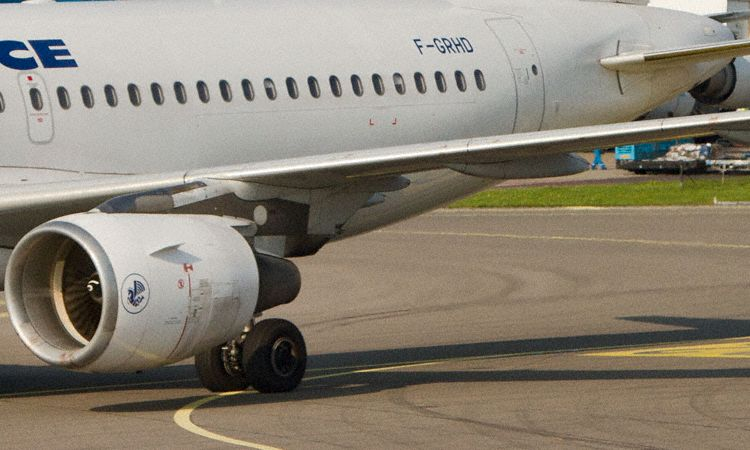
(Photo:Skeyes taken from avherald.com)
- 7 – St. Petersburg
Air Astana A320, on landing one or more birds impacted the right engine; next flight cancelled and aircraft grounded for one week;
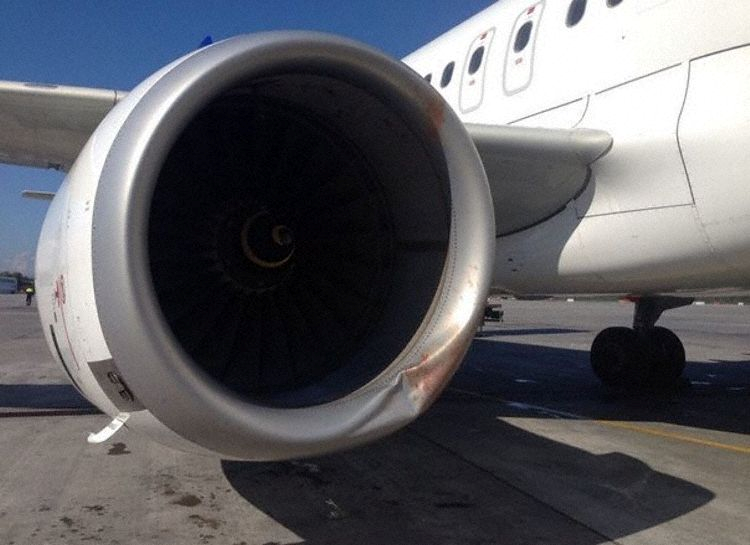
(Photo taken from avherald.com) - 8 – Juba
Egypt Air A320, on approach struck a bird that caused a cracked windshield; return flight postponed to the next day with another aircraft; - 9 – Zurigo
Edelweiss A330, at take off struck a large bird and the left engine showed vibrations; TWR confirmed that a large bird had found on the runway; after several tests to check engine parameters the crew decided to return; - 9 – Cluj
Wizz Air A320, at take off an engine ingested a bird; the crew initially continued the flight but then was forced to shut down the engine and divert to another airport about one hour later; - 11 – Palma de Mallorca
Niki A320, rejected take off at high speed following the ingestion of a number of birds into one engine that had to be replaced; - 12 – Amsterdam
Arkefly B737, suffered a bird strike on landing; - 12 – Amsterdam
KLM B737, rejected takeoff at high speed following a bird strike; - 13 – Amsterdam
Austrian Airlines A319, rejected takeoff at low speed following a bird ingestion into one engine; - 14 – Pereira (Colombia)
VivaColombia A320, during the initial climb a bird was ingested into one engine; immediate return; a landfill is located underneath the departure path of a runway; - 15 – Denver (CO)
United A320, on final impacted a bird that caused damage to the radome; - 15 – Barcelona
THY A320, bird strike on approach; next flight cancelled and aircraft grounded for 20 hours; - 23 – Johannesburg
Kulula B737, during the initial climb an engine ingested a number of birds; immediate return; - 23 – Pagadian (Philippine)
Cebu Airlines A319, during the approach the aircraft flew through a flock of American sparrows ingesting a number of birds into an engine; next flight cancelled; - 25 – Basel, Easy Jet A319
was rotating for takeoff f when the right hand engine ingested a bird; immediate return; - 27 – Alexandroupolis
Aegean A320, was accelerating for takeoff when an engine ingested a gull prompting the crew to reject takeoff;
This month presented several interesting cases. The events of the days 8 and 18 have been discussed above speaking about "abnormal parameters." Also significant are the events of the 10th and 11th: in both cases among the damages to the aircraft, there is also a broken passenger window, presumably due to the collision with a bird violently thrown by the propeller blade, and in the second (11) even minor injuries for a crew member. Finally, another multiple impact as a result of flying through a flock of birds in Burgas: this airport had already a similar event in 2008, and the following year, after the publication of the investigation final report, we commented the conclusions (see: Archives 2009 "September 3, a case to meditate on").
- 1 – Leipzig
Condor A321, bird strike during the initial climb; immediate return; - 4 – Amsterdam
KLM B747, at take off impacted with a bird that caused the first officer’s speed indications to be intermittently unreliable; after an attempt to continue the flight, the crew decided to return; - 5 - Nakhon Si Thammarat (Thailand)
Thai Air Asia A320, during the initial climb an engine ingested a bird; immediate return; - 7 – Philadelphia
Republic ERJ170, bird strike during the approach; minor damage; - 8 – Amsterdam
Easyjet A319, rejected take off at high speed after having spotted a flock of birds flying across the runway; - 8 – Dallas (TX)
Lufthansa A340, was climbing through 2000 feet when the crew observed a large bird hitting the aircraft at the right hand side of the nose; in the absence of any abnormal parameters the crew continued the flight to destination; a postflight inspection revealed the bird had left large dents at the right hand nose, parts of the bird went through engine #3, other parts impacted the slats; - 10 – Harrisburg (PA)
Piedmont DH8A, during the initial climb flew through a flock of geese receiving several bird strikes resulting in damage to the right propeller and a broken passenger window; immediate ruturn;
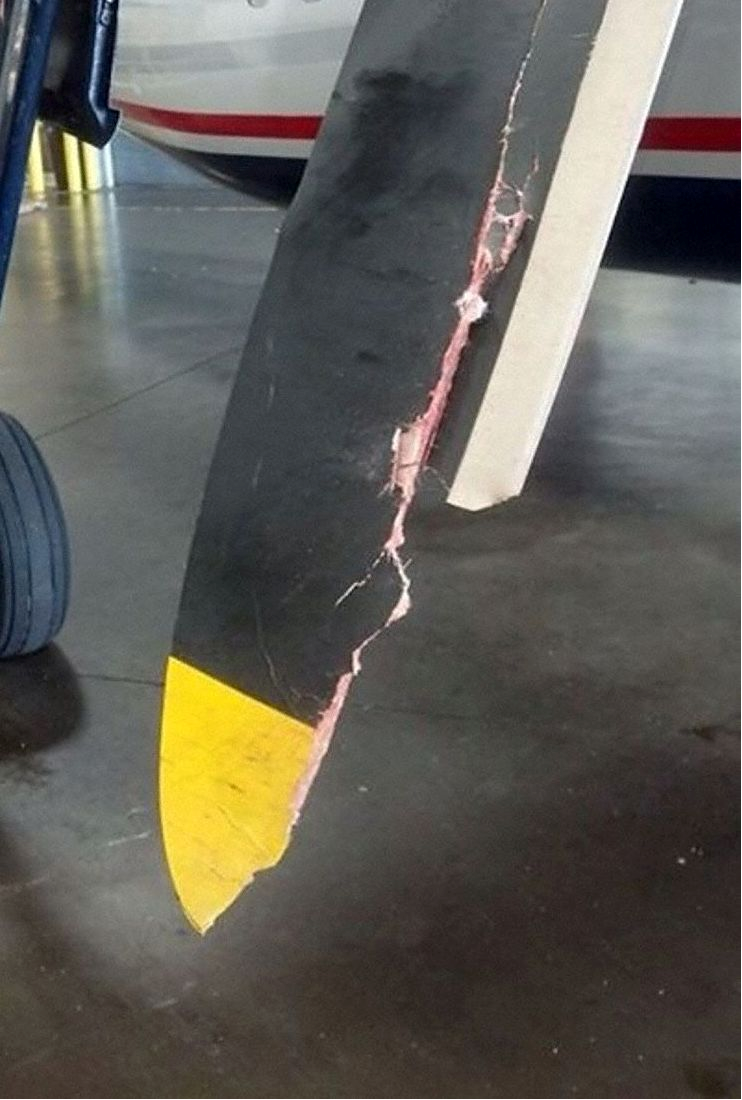
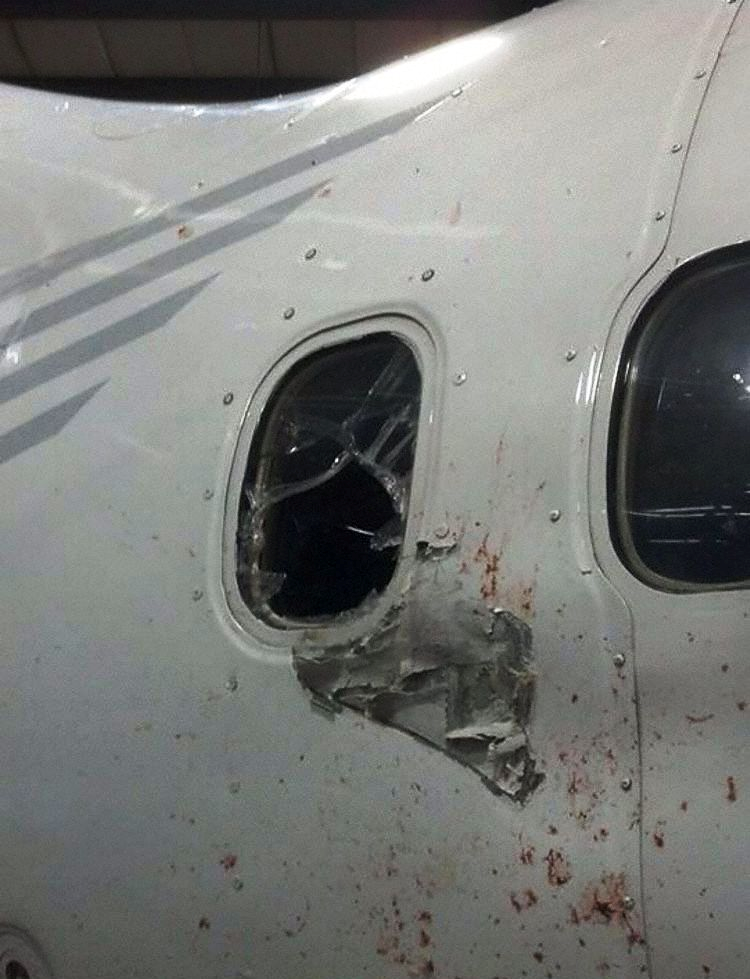
(Photos Peter Mercy taken from avherald.com) - 11 –Geneva
Swiss A319, during the initial climb a bird was ingested into the left engine; precautionary return but no damage reported; - 11 - Orlando (FL)
Silver Airways Saab 340, on final approach the crew declared emergency reporting they just had a bird strike causing debris all over the windscreen and a passenger window blown out; one flight attendant received minor injuries; - 14 – Tobago
Caribbean Airlines ATR72, bird strike at departure forced the aircraft to land; flight delayed of 4,5 hours after the aircraft was repaired; - 15 – Tbilisi
Lufthansa A319, bird strike during the approach; return flight delayed of 14 hours; - 18 – Istanbul
THY A321, at take off went through a flock of rather large birds and received a number of bird strikes; in the absence of any abnormal indications the crew decided to continue to destination;
a post flight inspection revealed the aircraft received damage to the nose gear, nose gear landing light, leading edge and slats of right hand wing, left engine inlet leading edge, there were indications that both engines had ingested birds; the return flight was cancelled; - 21 – Burgas
Bulgarian Air Charter MD82, during the initial climb crossing 1000 ft. flew through a flock of birds receiving several impacts; immediate return - 21 – Houston (TX)
United B737, at departure a bird impacted the aircraft; precautionary landing; damage to the leading edge of the wing;
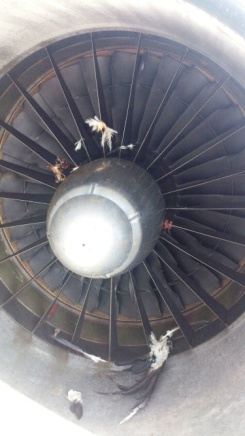
- 23 – Belem
TAM A320, bird strike on final approach and request of emergency services on stand by; next flights cancelled; - 24 – near Hyannis (MA)
Cape Air Cessna 402, while enroute struck birds and sustained damage to the leading edge of a wing which caused a diversion and landing; - 25 – Guersney
Aurigny Air Service ERJ195, bird strike at takeoff and immediate return;
http://www.bbc.com/news/world-europe-guernsey-28918294 - 26 – Amsterdam
British Airways Cityflyer ERJ170, bird strike at takeoff that led the crew to stop the climb and not to pressurize the aircraft fearing a structural damage; immediate return and flight cancelled; - 31 - Nakhon Si Thammarat (Thailandia)
Nok B737, during the initial climb flew through a flock of birds receiving multiple strikes; diversion to other airport about 25’ later and flight cancelled;
Two similar events occurred in this month reopen the old question of the continuation of the flight after a bird ingestion into the engines at take-off "in the absence of abnormal parameters." All those who follow this website can immediately notice the differences in the pilot behaviors in presence of similar cases; there are those who immediately land and those who decide to continue to their destination, only to then divert to another airport or realize on arrival that the aircraft has suffered significant damage. Of course there is also the possibility that the crew does not notice anything.
Given that the pilot discretion must remain a priority, there are questions however on what ground the pilots base their assessment on whether to continue the flight. In the case of Lufthansa A340 (August 8) the crew must surely have assessed they could fly several hours over the mainland with dozens of possible airports available in case of need, not to mention that losing an engine out of four is certainly not a tragedy, not even over the ocean. An immediate landing maybe would have made the consequences worse for the passengers and for the airline. However, even in this case the amount of damages suffered, if known before, would probably have suggested a different decision.
In the case of the THY A320 (18 August), even considering the route entirely on the mainland, the decision to continue can’t easily be justified, given the type of impact (the aircraft flew through a flock of birds) and the extent of damage suffered, certainly perceived by the crew. Furthermore it was a case of bird ingestion into both engines of a twin-engine. We know that the consequences of an ingestion, especially at take-off can occur hours and even days after the event, and - for example - a damaged fan blade can break suddenly putting out of order the entire engine.
The airlines generally do not have a common policy on the pilot behaviors for these cases, in fact most of the time they do not have any policy, delegating to them the duty and responsibility to take the most appropriate decision. In no airline manual one may find the order to land immediately after an impact with a bird, single or multiple. However, in a matter of fact they make psychological pressures on their pilots to hold down the costs, to bring back the aircraft to the airline headquarter, to not discharge tons of fuel, and so on.
Obviously not to the point of affecting safety: in presence of engine abnormal parameters landing is a must; however, there is a “gray zone” in which one is certain to have received an impact but everything continues to work properly and one does not know what to do: go back and discover that there is no damage, with the risk of receiving a scolding, or continue trusting in the aircraft.
We believe this is an issue that should interest not only the airlines (some indications on flight manuals would be appreciated) but also the aviation authorities.
A remarkable event happened in Dusseldorf (16) where there was another case of dual bird ingestion into the engines; the crew managed to stop the aircraft on the runway but in case of forced take-off the consequences would have been unpredictable. It is the fourth case this year and the second in Germany alone.
- 1 – Tunis
Tunis Air A320, bird strike at take off; immediate return; - 3- Dublin
Aer Lingus A320, during the initial climb a bird struck an engine that started to vibrate; immediate return 15’ later; - 3 – Dublin
Aer Lingus A320, during the rotation for takeoff a bird hit the left hand engine resulting in vibrations and unusual engine noise; the aircraft landed immediately with both engines running; - 3 – Auckland
Air New Zealand A320, rejected take off at low speed after a bird impacted the aircraft; - 3 – Basel
Easyjet A319, during the initial climb flew through a small flock of storks one of which was ingested in the left engine caising a loud bang and severe vibrations; te crew declared Mayday and the airport kept the runway sterile for helping to land; flight cancelled; a stork may weigh up to 4,5 kg; - 4 – Bruxelles
Egypt Air A320, during the initial climb a bird was ingested in the right engine; the crew did not declare emergency but required an immediate return; a fan blade was found completely damaged; - 7 – Stuttgart
Condor B757, during the initial climb a bird was ingested in the right engine causing repeated compressor stalls and streaks of flame; the crew shut down the engine and landed immediately; - 7 – Ponhpei (Micronesia)
United Airlines B737, during the approach the aircraft sustained a bird strike with ingestion into the right engine resulting in damage to 8 fan blades; - 10 – Dallas
American Airlines MD83, rejected take off after a bird ingestion into one engine; minor damage; - 11 – Girona
Transavia B737, on approach the aircraft flew through a flock of gulls suffering multiple impacts;
(Photo of Arjan van de Leur taken from avherald.com)
- 13 – Newark (NJ)
Air India B777, during the initial climb a bird was ingested into the left engine that had to be shut down by the crew; immediate return 20’ later; during the landing several tyres blew; - 13 – Trabzon
Pegasus B737, during the initial climb a bird impacted and fractured the windshield; immediate return 20’ later; - 16 – Dusseldorf
Lufthansa A320, before reaching V1 the crew rejected take off after having flown through a flock of birds receiving multiple impacts and bird ingestion into both engines; it is the fourth case this year and the second in Germany; - 28 – Batumi (Belarus)
Belavia ERJ195, during the initial climb a bird was ingested into one engine; immediate landing; - 28 – Istanbul
THY B737, during the initial climb flew through a flock of birds suffering several bird strikes; immediate landing; - 29 – Bangor (ME)
Chautauqua ERJ145, during the take off run a bird impacted the right main gear; minor damages; - 31 – Almaty
SCAT Airlines An24, during the take off run went through a flock of birds receiveing multiple impacts; the crew decided to reject take off at high speed; damages to the windshield, the nose and right hand propeller;
- 1 – Istanbul
THY B737, during the initial climb flew through a flock of birds and ingested at least one bird into one of the engines; immediate return; - 8 – Montevideo
Austral ERJ 190, during the takeoff run went through a flock of birds and ingested birds into the right engine; takeoff rejected at high speed and flight cancelled; according to some sources the birds would be some Southern Crested Caracara (Caracara plancus), weighing about 1 kg. each, that would have required the replacement of some fan blades;
(The Caracara plancus; photo taken from Wikipedia)

- 10 – Denver
UPS B767, during the initial climb the right engine ingested a bird prompting the crew to request an immediate return; during the approach they declared emergency; damage to right engine fan blades and cowling; - 11- San Antonio (TX)
Southwest B737, on landing received a bird strike and suffered minor damage to the horizontal stabilizer; - 17 – Manchester
Eurowings CRJ 900, on final approach a bird impacted the right pitot tube; return flight cancelled and replacement of the pitot tube; - 18 – Tampa (FL)
Southwest B737, during the initial climb flew through a flock of seagulls at about 2000 ft, and suffered at least one bird hit; given all the parameters normal the crew decided to continue the flight but then, after consulting with maintenance, decided to return immediately; minor damage to the leading edges of the wings and damage near the windscreen; - 18 – Parintins (Brasile)
Azul Linhas Aereas ATR72, on final approach an Urubu (Coragyps atratus) impacted the right hand side of the nose of the aircraft denting and puncturing the nose; flight cancelled waiting for spare parts to repair the damage; Parintins' public waste dump is located almost underneath the final approach about half a mile before the runway threshold;
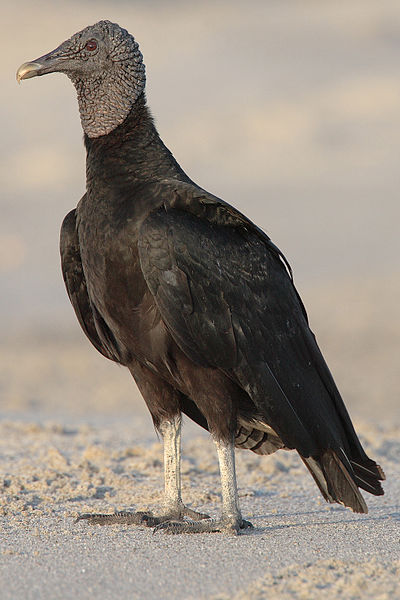
Urubu (Coragyps atratus); photo taken from Wikipedia - 26 – Geneva
Swiss A319, during the initial climb suffers a bird ingestion into one engine; immediate landing 30’ later; - 28 – Dallas (TX)
American MD83, during the landing roll struck a bird that caused damage to the left engine; - 30 – Biratnagar (Nepal)
Nepal Airlines Xian MA-60, during the approach a bird impacted the right propeller causing minor damage;
Years ago a “spectre” was wandering in the Italian skies: it looked like a bird but it was not, it was a model aircraft but made ??no sound and flew like an eagle. It was the Falco Robot, a brilliant all-Italian invention born to prevent and mitigate the presence of birds at airports. Basically a remote pilot could direct the flight of the model, which replicated in an impressive manner the shape of a large bird of prey, whose presence alone scared all the birds around who immediately abandoned the area for several hours. The device was tested at Genoa airport, where he drove to the high seas thousands of gulls settling on the outer breakwater and later at Fiumicino Airport for a month. The excellent results of this experiment were then presented at meetings and published and are also available on this web site.
One would have expected a wide use of the device in Italy, but since nobody is a “prophet in his own country”, this did not happen. Incidentally instead it met with some success in Latin America.
The patent was then sold to foreigners and the project put back in the drawer.
A few years after we see the outbreak of the drone-mania. Thousands of small machines of various shapes and types, equipped with highly advanced tools or with simple devices are now flying everywhere and even some bizarre restaurant manager uses them to deliver pizzas to the customer tables. Possible future applications are under study, like mail delivery at home, observation of vast agricultural areas, maintenance of power lines, so that the ENAC, rightly concerned about their impact on navigation safety, first in the world, adopted an ad hoc regulation, which could also be perfected but it is a step forward in the management of these devices. Devices that are now called APR in Italian (remote controlled aircraft) or SAPR (where “S” stands for system).
The Scientific Committee of the Study Center STASA, of which we are a member, recently had a meeting dedicated to the analysis of the problems arising from the use of these tools in the light of the new regulation of the CAA. Therefore we had the opportunity to bring back to life for some minutes the Falco Robot with the more modern guise of a SAPR, category to which it would belong today. We reaffirmed the absolute utility of the device at least for a tactical use (there was no chance to check its effects also in a strategic key, i.e. as a permanent deterrent), together with the difficulty of applying the new rules to this very useful product, which risks instead to be banned in the name of that same safety for which it has been created.
The regulation starts from the premise that SAPRs should be subjected to more stringent requirements and rules the closer they operate to an airport; and that is not a good start for devices born to operate right on the skies of airports. For the operations to be carried out in critical areas, and therefore at airports, then it should be made ??a request for the use of airspace, which already appears to be incompatible with the nature of the site, since they practically operate within the visual range of the Tower controller. This last assumption then leads to other problems about responsibility: who should be held responsible of the operations, the TWR or the remote pilot? And under what conditions, both the one and the other? What kind of contacts between them must be requested and by what means?
There are also many other concerns about the requirements of the remote pilot, his training, about the usefulness of some technical features of the device (even a transponder) when used in an airport, and so on. Another question regards the insurance, not just to contest its obvious necessity, but for emphasizing the difficulty for the insurer to establish its costs in the absence of historical records and a database of damages.
In conclusion we have a feeling that the regulator did not take account of this possible and desirable use of SAPRs as a bird dispersal tool at an airport, as well as other possible purposes related to safety (consider, for example, runway inspections, fence controls, apron surveillance etc ...). On the other hand we think that the law should address this innovation and set its limits, however without excessive bureaucracy (and costs) that could void the extraordinary potential of these new tools, in the name of that same safety it wants to protect .
The last month we reported an ingestion of bees into an engine; this month other insects caused an emergency landing (1) due to the occlusion of a pitot tube and the consequent airspeed data disagreement. Among the unfortunately common events, we point out that of day 13, because of the extent of damage, and that of day 14 because it presents again an old question: despite the crew was warned of a probable multiple birdstrike to an engine, in the absence of abnormal parameters they continued the flight , but were forced to divert almost immediately to another airport where they found out the bird ingestion. The old question is the crew training with regard to this type of events, as well as the policy of airlines.
New animal species enroll in the list of victims of wildlife strike, this time was a tapir weighing 250 kg . (30) that proposes the other old issue of airport fences, often missing or inefficient. This does not happen only in small airports in third world countries considering the umpteenth accident caused by a deer on the runway in the U.S.; this time the news is really amazing (30) because it happened at Charleston International Airport (source: FAA) .
- 1 – Montego Bay
Sunwing B737, during the takeoff run an airspeed disagree message appeared on the display; the crew continued takeoff, after becoming airborne declared emergency and immediately landed; a post flight inspection found insects blocking the first officer's pitot tube; - 2 – Orlando
Southwest B737, ingested a large bird in the left engine at takeoff causing vibrations and engine to be left at idle; immediate return; - 3 – near Baltimore
Priv. Cessna 172, upon landing struck a deer on the runway causing nose gear to collapse; - 4 – Chania
Enter Air B737, during the initial climb a bird was ingested into an engine; the crew burned off fuel and returned about 50’ later; - 5 – Dusseldorf
Eurowings Canadair CRJ 900, during the final approach a bird impacted the aircraft nose causing damage to radome and weather radar that had to be replaced; - 7 – Brasilia
TAP A330, multiple impact duringtake off with some birds ingested into an engine; Immediate return 17’ later; flight postponed to the next day;
http://www.estadao.com.br/noticias/cidades,aviao-que-ia-de-brasilia-a-lisboa-bate-em-ave-e-tem-de-retornar-apos-17-minutos,1163626,0.htm - 8 – Frankfurt,
Lufthansa A319, during the initial climb a bird impacted the left engine's cowl causing a dent at the engine inlet; immediate return 25’ later;
(Photo taken from avherald.com)
- 9 – New York (La Guardia)
USAir A319, during the initial climb the left engine suffered a lot of vibrations due to the ingestion of birds; immediate return 15’ later with both engines running; flight cancelled; - 13 – Karlovy Vary
Ural Airlines A320, birdstrike during the initial climb with probable ingestion into one engine which caused remarkable engine vibrations; immediate return 30’ later; - 13 – New York (JFK) UPS B767
during the approach flew through a flock of large birds, apparently geese at about 800 feet AGL and received damage to the wings and the left hand engine; - 13 – Sugar Land (TX)
Priv. Raytheon 400°, at take off a bird was ingested into one engine causing a small fire and a fuel leak; immediate return;
http://www.click2houston.com/news/bird-strike-causes-engine-fire-plane-to-return-to-sugar-land-airport/25958388 - 14 – West Palm Beach (FL)
Delta B757, after takeoff the crew was told that another aircraft on the ground had observed birds hitting the right hand engine; in the absence of abnormal parameters the crew decided to continue the flight but then stopped the climb at 14,000 feet and diverted to another airport about 30’ later; a post flight inspection revealed that the right engine had ingested a bird; - 16 – Enroute between Taiyuan and Hefei (China)
Hainan Airlines B737, during the flight the aircraft encountered a bump which was believed to be the result of clear air turbulence; a post flight inspection revealed a large dent in the nose cone caused by a bird strike;
(Photo taken from avherald.com)
- 19 – Filadelfia
Republic Airlines ERJ175, bird strike on final approach; damage to the leading edge of the right wing; - 26 – Washington (DC)
Expressjet CRJ200, during the initial climb the right engine was struck by a bird; immediate return 20’ later; - 27 – Boston (MA)
Jetblue A320, at takeoff the crew observed two geese on the runway; moments later one bird struck the nose gear door causing noise and vibrations and forcing to an immediate return; a post flight inspection revealed that the second goose had been ingested by the right engine; - 30 – Coari (Brazil)
Total Linhas Aereas ATR42, during the takeoff run collided with a tapir (Tapirus terrestris) which bent the right hand main gear; the crew continued to destination (Manaus) where performed an emergency landing after having burnt off fuel; the runway of Coari is 1600 mt. long while at Manaus there are 2700 mt.; an adult tapir can attain an average weight around 250 kg;
(Photo: Emergency Services Manaus taken from avherald.com)
- 30 – Charleston (SC)
Priv. Cirrus SR22, during the landing roll struck a deer on the runway.
The AIB concludes its report stating that “it is difficult for an airport operator to mitigate the risk of birdstrikes under such conditions, as it is unrealistic to expect a complete control of or warning capability against birds residing at unspecific locations away from the airport”. We think that such statement, as well as that previously released by the same agency on the impossibility to avoid birdstrikes, is – to put it mildly - rather controversial and with a subtle flavor of capitulation.
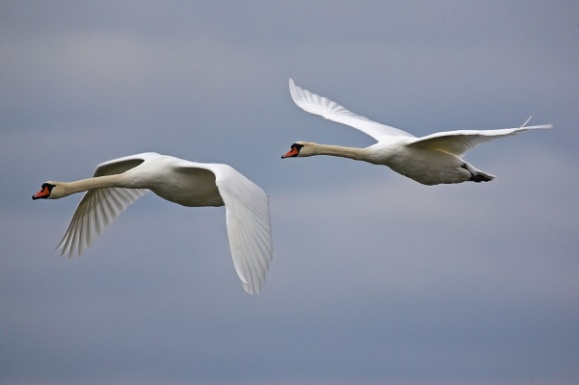
(Photo taken from Wikipedia)
The Indonesian authorities have released their final report concerning the serious incident occurred at the airport of Gorontalo on 06 August 2013 (see Archive 2013), when a Lionair B737 during the landing roll impacted with some cows that were crossing the runway. The aircraft veered to the left and came to a stop on the left runway shoulder. No injuries occurred on board apart from two passengers that received sprained ankles as result of their evacuation, which was not ordered by the crew. Contributing factors to the event were the presence of cattle farms close to the airport and the broken or not installed fences around the airport perimeter.
This month we have at least two events that deserve a comment. The most serious undoubtedly occurred in Cardiff (21) where there was another case of dual ingestion of birds in both engines (of a twin-engine). Once again, unfortunately, the crew in the absence of immediate abnormal parameters decided to continue the flight, but pretty soon they had to divert. Events of this type, which could have catastrophic effects, are becoming too frequent: that’s the third case of 2014.
The other relevant case regards the ingestion of bees in the engines of a MD82 (14); in general the impact with a swarm of insects might occlude the pitot tubes causing the loss of airspeed data, and in this case it certainly caused an expensive aircraft downtime to allow the necessary inspections and cleaning operations.
- 4 – Valledupar (Colombia)
Avianca A320, was climbing after takeoff when a bird, probably a buzzard, at 700 ft. hit the left engine causing vibrations; immediate return and flight cancelled;
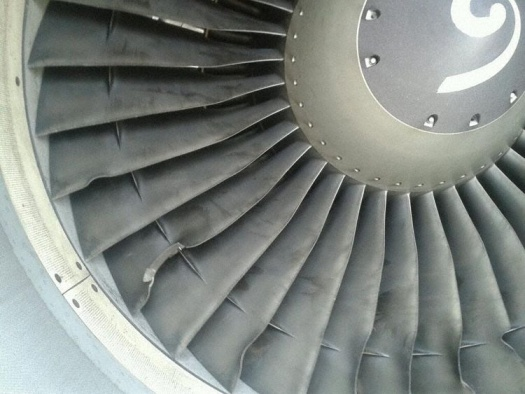
(Photo: Vallenato 31, taken from avherald.com) - 5- Sao Filipe (Cape Verde)
TACV Cabo Verde Airlines ATR72, on approach one of the propellers impacted with a Rufous-capped Anttrush (Formicarius colma); despite the little mass of the bird (it weighs about 45 g.) the aircraft could not perform the return flight;
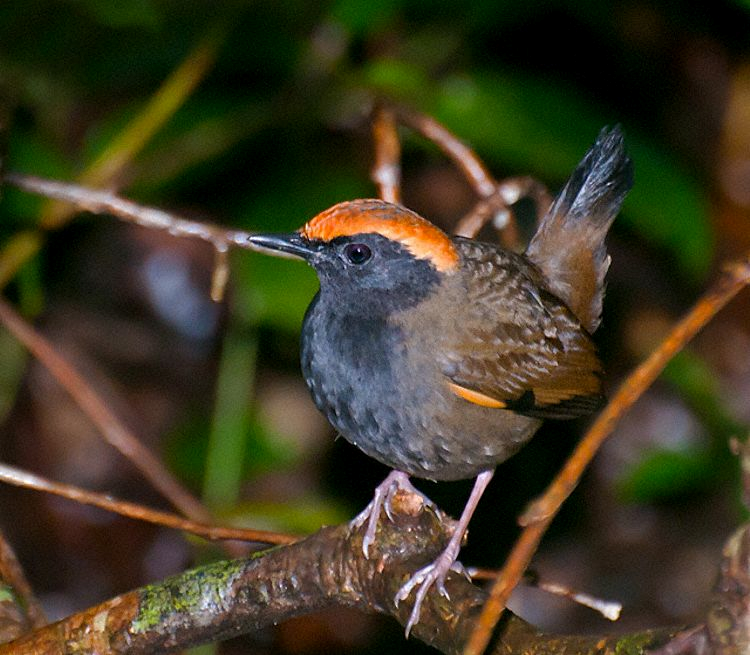
(Photo of Dario Sanches, taken from Wikipedia) - 5 – Munich, Air Berlin A330
at the rotation the right engine ingested a bird emitting a loud bang; the crew continued the takeoff, climbed to 9000 feet, shut down the right engine and landed about 20 minutes later; - 12 – Kinshasa
Compagnie Africaine Aviation A320, after takeoff the left engine ingested a bird; immediate return; - 12 – Goiania (Brazil)
TAM Linhas Aereas A320, during the takeoff run the left engine ingested a bird; takeoff rejected and flight cancelled; - 14 – Las Vegas (NV)
Allegiant MD82, returned after a suspected birdstrike but a post flight inspection revealed that the aircraft instead had flown through a swarm of bees with a large quantity of bees impacting and obscuring the windshield and parts of the swarm being ingested into the engines, not causing loss of power however;
http://www.reviewjournal.com/news/las-vegas/bee-swarm-forces-outbound-las-vegas-flight-land - 16 – Xiamen
China Eastern A320, after takeoff climbing through about 5000 feet a bird impacted the first officer's windshield causing the windshield to crack; immediate return in emergency and flight cancelled; - 21 – Cardiff
Thomson B737, at takeoff a number of Herring gulls were ingested into an engine; in the absence of abnormal engine indications the crew continued the climb; about one hour later the crew decided to turn around and divert to another airport due to an abnormal smell of "roast chicken" developed in the cabin; a post flight inspection revealed that also the other engine ingested birds; - 22 – Minneapolis (MN)
Skywest CRJ200, during the initial climb impacted with a large bird; immediate return after 10’ from takeoff; damage to the nose cone; - 28 – Hazlehurst (GA)
Priv. Beech 36, on landing struck a deer on the runway;
- 3 - Opa Locka (FL)
Priv Cessna 525, during the initial climb struck a bird and returns immediately; damage to the right wing; - 6 – Port Elizabeth
Comair B737, at rotation the right engine ingested a large bird, reportedly a Sacred Ibis (Threskiornis aethiopicus); immediate return with a number of fan blades bent;
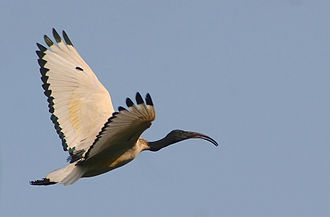
(Photo taken from Wikipedia) - 9 – Johannesburg
Cathay Pacific B747, during the initial climb the aircraft flew through a flock of birds and ingested a number of birds into engines #3 and #4 (both at the right hand); the crew shut the engine #3 (inboard) down due to abnormal indications but kept #4 operating with normal indications; after another hour of flight for dumping fuel, the aircraft landed safely; a post flight inspection established birds had been ingested into both right hand engines causing damage to both; it is the first case of multiple ingestion in 2014;
http://citizen.co.za/141063/emergency-landing-ort/ - 10 – Minneapolis
Delta B737, on departure a bird impacted the right wing; ground personnel however observed a number of large birds hitting the aircraft; immediate return; damage to the wing; - 16 – New Orleans (LA)
Priv. IAI 1124 Westwind, an engine ingested a bird at take off; - 17 – Berlin (Schonefeld)
El Al B737, after take off, crossing 3600 ft. the crew declared Mayday reporting bird strikes into both engines, which however were running normally; while positioning for the approach the crew reported trouble with one of the engines that later needed to be replaced; a post flight inspection revealed that only one engine ingested birds; other damage to the nose cone and the leading edge of the wing; - 21 – Kathmandu
Malaysia Airlines B737, on approach a bird impacted the nose gear damaging the landing light; return flight delayed of 19 hours; - 28 – Westchester (NY)
JetBue A320, during the initial climb hit some birds one of which remained stuck in the nose cone; diversion at lower speed to another airport about 30’ after departure;
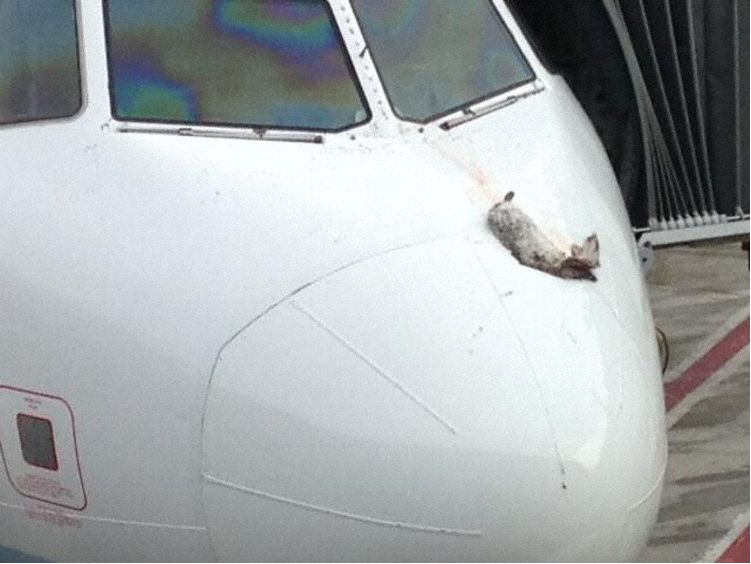
(Photo of Chris Balduino taken from avherald.com) - 29 – Campo Grande
Avianca F100, during the approach a bird strike causes a sensor failure that shows an unsafe gear indication; the crew decided to go back to the airport of departure; the gear operated normally; the flight was cancelled; - 30 – Washington DC
Southwest B737, during the approach struck a bird that caused damage to the nose cone; - 30 – San Jose (Costa Rica)
United Airlines B737, during the approach suffered a bird strike that caused damage to one wing; return flight cancelled; - 31 – Washington DC
Republic Airlines ERJ170, on short final hit a bird whose carcass was recovered on the runway threshold; the aircraft suffered damage to the pitot tube;
First of all it must be noted that the occurrence was so far unknown. On 23 July 2013 a SAS B737 bound to Oslo, after takeoff and at an altitude of 800 ft. impacted a number of Common Shelducks (Tadorna tadorna), birds belongings to the family of Anatidae.
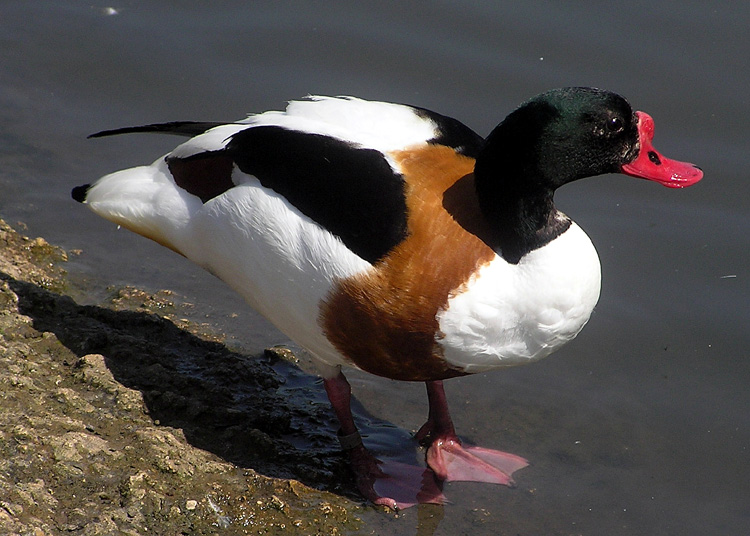
The impact regarded mostly the left engine which suffered significant damage and showed an increase of vibration but not a loss of thrust. For this reason the crew decided for an immediate return to Copenhagen Kastrup airport using both engines. More details on this event can be found in the final report released by AIB DK.
Particularly interesting in our opinion are the AIB conclusions that highlight a certain "fatalistic" attitude towards birdstrikes.
After mentioning the number of impacts occurred in Kastrup in 2012 (141, with a rate n/10K movements of 5.8) and in 2013 (105, 4.29), the Agency points out that with high probability they were migrating birds. The rate n/10K is an old risk index, now replaced by more modern risk assessment matrixes, but in any case the values ??close to 5 are already quite relevant.
Based on the history of birdstrikes, the AIB DK “does not consider Shelducks as a specific problem at Kastrup”. However, large numbers of migrating birds in the area “could be a threat in the future”. Furthermore considering that from 2012 to 2013 either the number of impacts or the rate decreased, that means the airport initiatives are successful. According to the AIB, a contributing factor was the circumstance that the team of Bird Control did not observe the flock of birds in flight (at 800 ft, 250 m) nor was able to intervene in any way. In addition, specific preventive activities against Shelducks are carried out from April to June, and the incident would have occurred out of season. For these reasons, the AIB does not issue any recommendation. The report ends with the remarkable statement that "it is not possible to avoid the birdstrikes."
From a long time we make on this website a statistical analysis of dual ingestions, i.e. ingestion of birds into two or more engines of the same aircraft. The most known was the one that occurred to the USAir flight 1549 on 15.1.2009, then ditched in the Hudson River. However most of the time, despite the ingestion, all or some engines still deliver the necessary power to land.
The event that we are considering occurred in Johannesburg on 9 March 2014, when a Cathay Pacific B747 shortly after takeoff flew through a flock of birds, some of which were ingested into both engines located on the right wing.
The B747 however, completely lost only the engine no. 3 (inner right), shut down by the crew, while the n. 4 (outer right), although damaged, continued to work. This allowed to perform normal three engines procedures so that the airplane flew for one more hour consuming fuel before landing back at the South African airport.
It is a fact , however, that a concrete possibility of a complete loss of two engines on the same wing really existed. The question we pose is whether under these conditions the airplane was still maneuverable, given the highly asymmetric thrust, the takeoff weight, the airport altitude, located at about 1700 m. asl, and the many other factors to be taken into account when planning the flight.
We therefore asked for an opinion a leading Italian expert on Flight Safety and Investigations , Captain Renzo Dentesano , who kindly so responded :
" A B747, once the V1 has been reached on the runway, is forced to go airborne, and if it manages to overcome the V2 and mainly the initial climb over the obstacle (which ends with the retraction of the landing gear ), is controllable in flight even with 2 engines on the same wing out of order (better if at least one on idle ! ) …..... The initial and then the recurrent training at flight simulator requires the carrying out of this emergency procedure once a year and all the maneuvers are reported in the Airline Operation Manual (memory items) - section emergencies …..All the rest…. is stuff for test pilots "
Up to this point is the expert's opinion. We therefore should conclude that one thing is the in-flight engine failure, another one is when it happens at takeoff: the former allows a certain margin for manoeuvre, the latter much less. Instead the assumption of a double engine failure on the same wing at take-off is not taken into consideration at all by airline operation manuals because it goes beyond the aircraft certification requirements . However it is possible that, at the level of flight tests, one can theoretically be able to take off under certain conditions, which certainly do not occur in scheduled flights. Furthermore we have to consider that a remarkable part of bird ingestions occurs just during the takeoff run, either because birds are settling close to the runway, or because they suddenly cross it. In conclusion, if both right engines of the 747 had stopped working after the ingestion (absolutely possible occurrence), there are strong chances that it would have resulted in a catastrophic event. Therefore we consider the Johannesburg incident as one of the most serious events in recent years. And since the flight through a flock of birds at takeoff is a relatively frequent event, the discussion must necessarily focus on the preventive measures on the ground in order to prevent, as far as is humanly possible, that flocks of birds roam uncontrolled and unpredictable within an airport or in the takeoff path.
Below, to be clearer, we report the double ingestion cases occurred only in 2013, fortunately all happily ended, proving they are not so rare events:
19/01/2013 - Orlando, Virgin Atlantic A330 (twin-engine), during the initial climb a number of birds are ingested in both engines one of which must be shut down; about 30’ later landed with only one engine and over the maximum weight allowed; damage to both engines, to the leading edge of both wings and the radome;
16/04/2013 - Dallas, American Airlines MD82 (twin engine), at take off a number of birds were ingested in both engines;
29/11/2013 - Manchester (NH), Southwest B737 (twin engine), at take-off flew through a flock of small birds some of which were probably ingested into both engines that still continued to run regularly;
Some considerations on two events of this month. In the first (22) the TWR warned the crew about the presence of birds at about 1000 ft. The controller’s behavior is correct and in the United States, differently from other countries, is ruled by the FAA regulation that makes it mandatory. The crew, however, decided to land anyway with the result of multiple birdstrikes with probable aircraft downtime and various maintenance works for many thousands of dollars. We do not know the technical reasons for this behavior but we wonder which kind of training pilots receive for facing these events and what the airline manuals say on this regard. In other words, if even a TWR warning does not produce any effect on the flight, may be pilots are not provided with all the requirements needed for a proper risk assessment. From this perspective then even the complex information system, through AIP, NOTAM and ATIS on the presence of birds, does not make sense.
The second (27) presents again the same old problem of an impact followed by "normal parameters", that leads to the continuation of the flight till destination. As first, the failure of the weather radar should have made the crew suspicious; then the photo explains better than any other comment the aircraft conditions: we wonder what damage could result if a part of the nose cone had detached and had struck a wing or had been ingested into an engine. For the record, the bird involved seems to be a goose.
- 5 – Terceira
TAP A321, during take off a bird has been ingested into one engine; immediate return and flight delayed; - 15 – Hefei
China Eastern A320, at takeoff the right engine ingested a bird that prompted the crew to shut it off; immediate return 15’ later; flight cancelled; - 22 – Philadelphia
UPS B767, on a visual final approach the TWR advised of birds at about 1000 ft.; the aircraft continued for landing but suffered multiple bird strikes; - 27 – Copenhagen
Swiss A320, in the initial climb a bird impacted the radome; the crew, not detecting any abnormal handling or performance of the aircraft, continued the flight to destination; a postflight inspection revealed the bird had penetrated the radome, damaged the weather radar and got stuck at the lower right part of the radome;
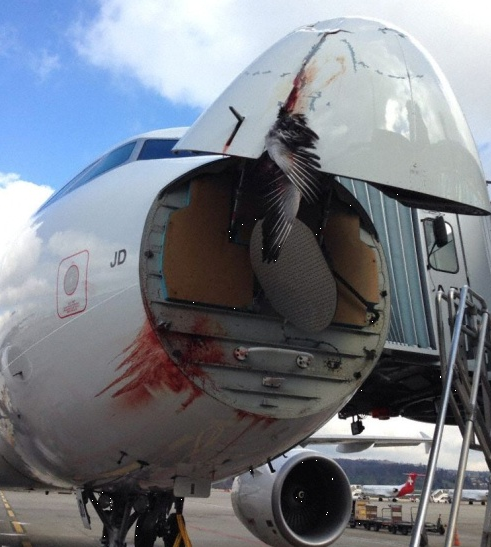
(Photo taken from avherald.com) - 28 – Dallas
American Airlines MD82, during the initial climb the left engine ingested a bird; precautionary return and minor damage to the engine;
Valter Battistoni, founder and manager of the website www.birdstrike.it , has been appointed member of the STASA Scientific Committee (www.stasa.it). STASA is an independent association offering a range of specialist aviation consulting and monitoring services. The association integrates aspects of air traffic control, navigation, safety, investigation and law aspects combining a team of people with not less than twenty years of experience.
In the late afternoon of 4 February the concurrence of extreme meteorological events caused thousands of gulls to invade the airport of Genoa. Indeed, the presence of snow in the inland, the sea storm on the close tidal barrier and the continuous heavy rain caused the birds to spend the night on the runway and taxiways rather than in the usual places.
Airport authorities could not do anything against the huge number of birds also because is almost impossible to disperse such a mass of birds in the dark. Very opportunely they did not wait that an incident occurred, but immediately decided to issue a NOTAM closing the airport. Many flights were canceled or diverted to other airports, causing significant inconvenience to passengers.
Although such a concurrence of events can be defined exceptional, it is not the first time that this occurs even if in the past the gulls invaded only the apron .
From a long time Genoa airport struggles with the problem of gulls, taking all possible known countermeasures and strategies, recently reporting risk indexes in line with many other airports. However, the environmental conditions, the presence of Scarpino landfill nearby, the breakwater dam and the abandoned areas of the former ILVA steelworks are formidable attractive elements. The problem will therefore remain unsolved until a solution will be found with the management of these sites, in particular the landfill. With regards to this we should consider that the closure of Malagrotta landfill resulted in a dramatic decline in the number of impacts, and in the consequent risk index, at the nearby airport of Rome Fiumicino, clear sign of a close relationship between these plants and bird strikes.
Can bird strike mitigation and eco-consciousness co-exist? Converting airport grasslands to solar arrays or installing vegetated roof spaces on buildings is compatible with bird prevention policies that instead exclude all possible perches or attractive sources for birds inside airports?
Some researchers think so, according to an article published on the magazine Jane’s Airport Review (January 2014).
The topic is undoubtedly interesting even though the researches and studies cited seem to be still insufficient.
Experience teaches us that each airport has unique environment and features so that before applying this concept on a large scale it would be appropriate waiting for further studies and field tests.
- 2 – Trondheim
Norwegian B737, during the initial climb a swan impacted the leading edge of the left wing causing a big hole;
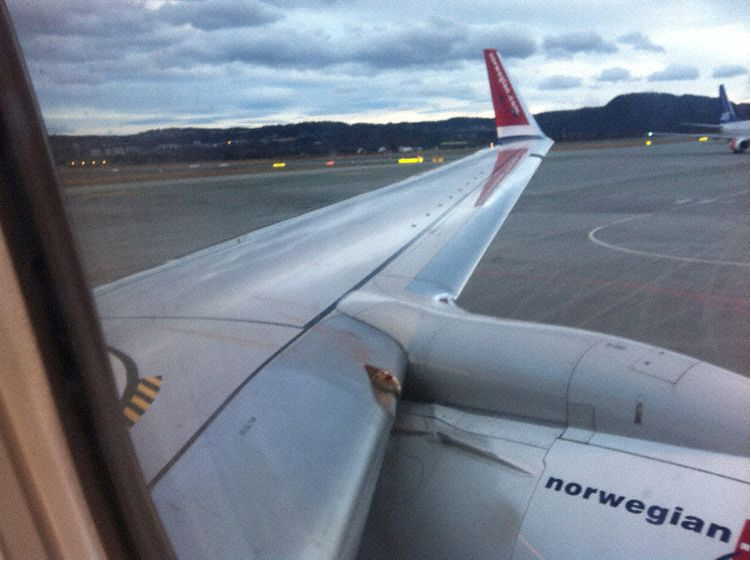
(Photo by Kristine Askvik/Askvikmedia taken from avherald.com) - 18 – Salt Lake City (UT)
Southwest B737, bird strike on final approach that causes minor damage to the nose gear light; - 19 – Frankfurt
Air Malta A319, during the approach struck a bird; due to the damage suffered the next flight has been cancelled;
http://www.independent.com.mt/articles/2014-01-19/news/air-malta-frankfurt-flight-in-bird-strike-incident-3725918209 - 20 – Mombasa
Condor B767, rejected take off at high speed due to the ingestion of a heron in the left engine; in spite of the smell in the cabin, the engine did not suffer any damage and the flight could be continued about 2,5 hrs later; - 28 – Orlando (FL)
JetBlue A320, on departure suffered a bird strike; immediate return; right engine damaged; - 31 – Athens
Air Malta A320, during the approach struck a bird; next flights cancelled;
